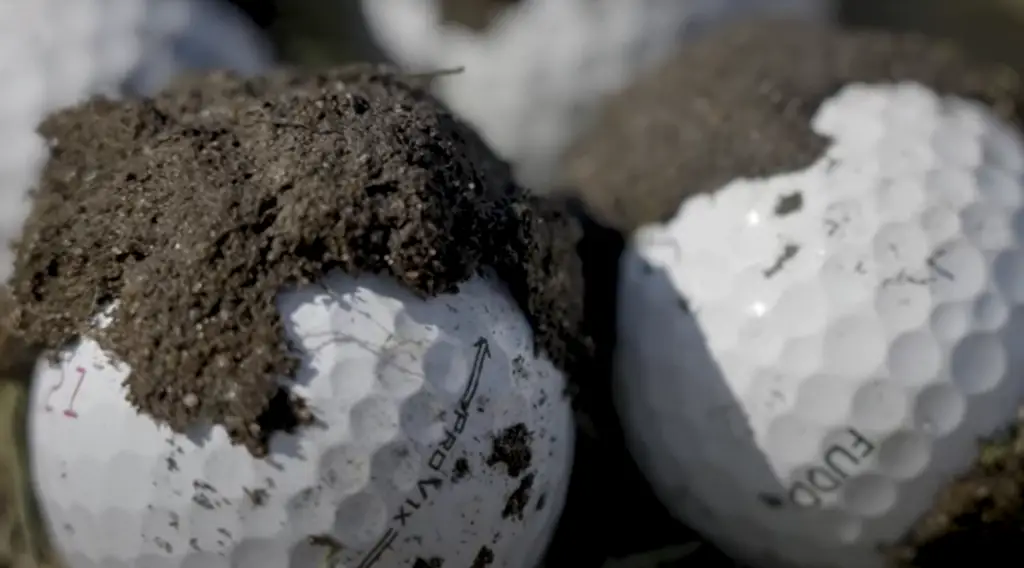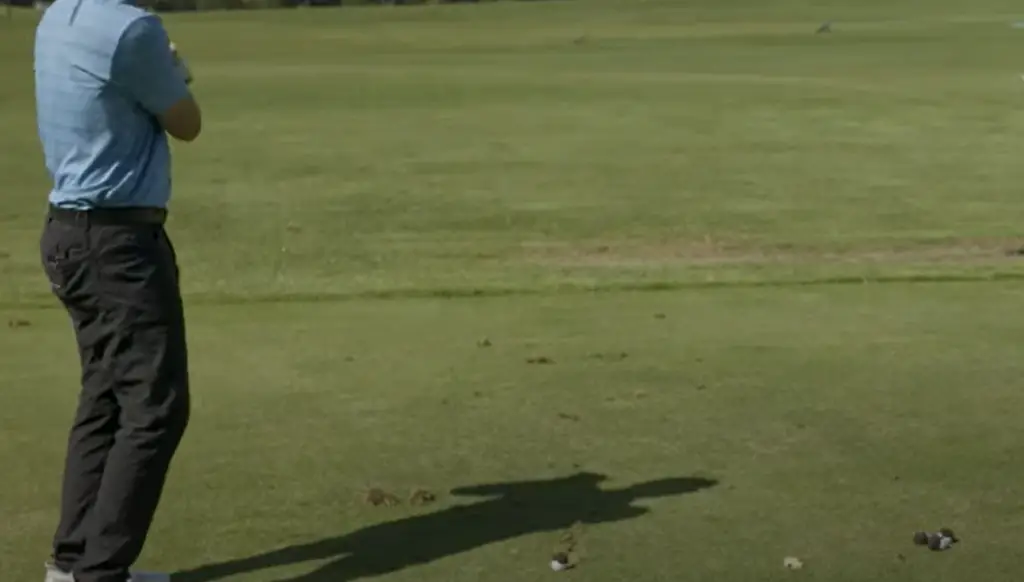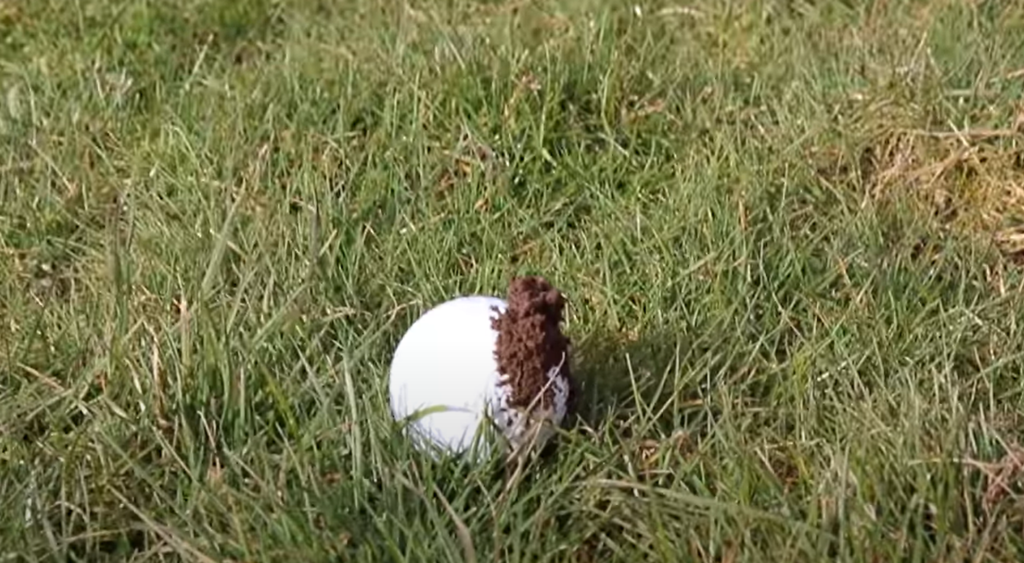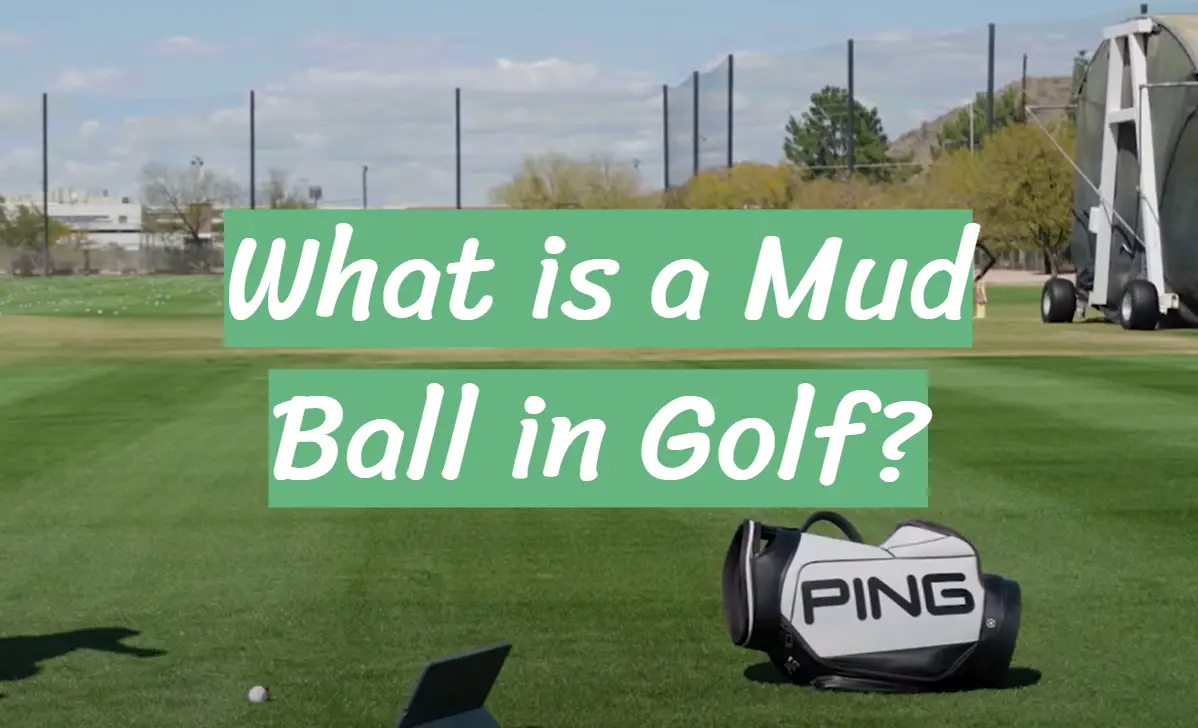What is a mud ball in golf? This is a question that many golfers ask themselves, especially when they find themselves playing in wet conditions. A mud ball is simply a golf ball that has been covered in mud. When you hit a mud ball, it will not travel as far as a clean ball, and it will be more difficult to control.
A mud ball is also a golfing phrase that refers to a golf ball with varying amounts of muck attached to it. Mud balls are all too often seen on wet courses, and they occur when a club strikes the ball at impact or when a ball falls in a muddy area of the course [1].
When a mud ball is hit, it will travel a significantly shorter distance than a clean ball because of the added weight from the mud. In addition, control over where the ball will go becomes more difficult because of the uneven surface area.
In this blog post, we will discuss the causes of mud balls and how to avoid them!
Table of Contents
The Mud Ball Explained
A mud ball is a standard golf ball with muck adhering to part or all of the surface. If you hit the ball with muck on it, the flight will be influenced.

There are times when cleaning mud off a ball is permissible, and as a player, you’ll want to take every opportunity possible to remove anything that might affect the ball’s flight or spin.
There are two types of mud balls: those that have dried and hardened on the outside, and those that are still wet [2]:
- Dried mud balls are much easier to hit than wet ones, but they will still not travel as far as a clean ball. If you find yourself hitting a lot of dried mud balls, you may want to consider using a different type of club or changing your swing;
- Wet mud balls are very difficult to hit, and they should be avoided if at all possible. If you must hit a wet mud ball, use a club with less loft and try to make contact with the ball as close to the center as possible;
Mud balls can be a nuisance, but if you know how to deal with them, they needn’t be a problem. With a little practice, you should be able to hit them just as well as any other type of ball.
What Happens with a Mud Ball?
With a mud ball, the club will not be able to slide through the grass as easily. This can cause the shot to go slightly off course. The ball will also not travel as far as it would with a clean hit.
In addition, hitting a mud ball can damage your clubs. If you have any choice in the matter, it is always best to choose a different ball [3].
There are some instances where you may not have a choice but to hit a mud ball. In this case, try to take shallow divots and swing easily so that you make contact with the ball without too much force. It is also important to focus on where you want the ball to land and maintain good balance throughout your swing. Remember to clean your clubs afterward to avoid any long-term damage.
Can You Clean Mud Off Your Golf Ball on the Golf Course?
The answer is yes, but it’s not as easy as you might think. You can’t just wipe the mud off with your hand or a towel; you need to use a special golf club or brush designed for cleaning balls. And even then, it can be tough to get all the mud off without damaging the ball.
You must play it where it lies as a general rule.The lift, clean, and place policy is an exception, however.
According to this regulation, you can identify the location of your golf ball, lift it, clean it, and then return it to its original position.

There are strict procedures for how to identify the location, lift the ball, clean it, and place it back. You will be fined if you break even one of the rules [4].
During the game, a player may check to see if the ball is okay. This is crucial since you will be unable to assist a playing partner with ball identification, resulting in an infraction.
Once you’ve caught the ball, you must look for it to be embedded in the ground.
If the ball made a dent or crevice in the ground, and the ball was sitting at a lower level than ground level, the player may set it back down outside of the embedded area where the ball was originally discovered using a clean club [5].
How Does Mud Affect Golf Balls?
Mud can have a few different effects on golf balls. It can cause the ball to spin more, which can be good or bad depending on how you hit it. It can also make the ball fly further or shorter than usual. And finally, it can affect the trajectory of your shot. All of these factors must be considered when you are playing in mud conditions [6].
You must be able to adjust your game accordingly. If you are having trouble with your shots in the mud, don’t be afraid to ask for help from a professional golfer or coach. They will be able to give you some tips on how to improve your game.Mud can also cause the ball to stick to the club, which can lead to inaccurate shots. If this happens, be sure to clean your club as soon as possible. Mud can also make it difficult to see where your ball is going, so always be aware of your surroundings.
How Do You Hit a Mud Ball?
There are a few ways you can hit a mud ball, but the most common way is to use your pitching wedge.
This will help to ensure that you don’t hit the ball too high and cause it to go into the water hazard.If you are able to make contact with the ball and get it airborne, then congratulations! You have just hit one of the most difficult shots in golf. Now all you have to do is land it on the green and hope for a nice two-putt.

Mud balls can be very frustrating, but if you can master them then they can be some of the most satisfying shots you hit all day. So next time you are out on the course and find yourself in a mud ball situation, remember to keep your head down and swing easy. With a little practice, you’ll be hitting them like a pro in no time.
FAQ
Why do golfers say “mud ball”?
A mud ball is a small, hard-packed mass of dirt that forms on the ground during wet weather conditions. When a golf ball hits a mud ball, it can cause the ball to spin erratically or change direction.
Golfers often use the term “mud ball” to describe any shot that goes wrong because of bad lies or poor course conditions.
Mud balls can be difficult to hit because they offer little traction for clubheads. They can also cause problems when trying to read greens, as they can distort the true path of the ball.
If you find yourself hitting a lot of mud balls, try using a more lofted club or taking a steeper swing to get underneath the ball. You can also try hitting the ball on the upswing to help it get airborne.
What is the best shot in golf called?
A “pitch shot” (or simply “pitch”) is a shot hit with a club that has been lofted to a great degree and is intended to go only a short distance with a significant climb and fall.
Pitch shots are aimed toward the green, generally from 40-50 yards and closer [7]. When compared to the chip shot, it’s easy to envision how a pitch shot looks.
A chip shot is hit with a club that has less loft (generally a higher numbered iron) and is intended to travel along the ground for a shorter distance.
Pitch shots are often needed when your ball lies on tight, high grass or in light rough just off the fairway.
It’s important to make good contact with the ball and not “fat” the shot, as this will result in a loss of distance and control. When you make great contact, the ball will fly high and land softly on or near the green, stopping quickly.
Can you clean your ball in the fairway?
No, you cannot clean your ball in the fairway. If your ball is lying in a puddle of water or mud, you must take a penalty stroke and play the ball as it lies. You can however try to improve your lie by using a club to move the water or mud around your ball (but don’t touch the ball!) [8].

If you hit your ball into a bunker and it’s covered in sand, you are allowed to clean it before hitting it out of the bunker. The same goes for if your ball is on the green and covered in leaves or other debris; you are allowed to clean it before putting.
Where is the mud ball place?
The mud ball is placed just behind and to the left of the golf ball. It is important to remember that the mud ball should be placed in the same spot for every shot. This will help ensure that your shots are consistent [9].
Now that you know where to place the mud ball, it’s time to hit some balls! Try to keep your shots straight and avoid hitting the trees or other obstacles on the course.
How much does mud affect a golf ball?
The amount of mud on a golf ball can have a big impact on how the ball will fly. If there is a lot of mud on the ball, it can cause the ball to spin more and fly shorter distances. If there is only a little bit of mud on the ball, it might not have much effect at all.
Mud also affects how well you can see the ball. If there is a lot of mud on the ball, it can be hard to see where you are hitting it. This can make it difficult to aim your shots.
If you are playing in conditions where there is a lot of mud, you might want to consider using a different type of golf ball that is designed for these conditions.
What is the rule for a plugged golf ball?
Golfers are entitled to free relief under the embedded ball rule, which is Rule 16.3 of the Rules of Golf.
Golfers are entitled to free relief from a position in which their ball becomes embedded in the general area (also known as “through the green”), which includes everywhere on the course that’s not teeing ground, putting surfaces, bunkers, and hazards [10].
If a ball is embedded in its own pitch mark as a result of the previous stroke, and part of the ball is below the ground level, it is considered to be so. The ball does not need to be laid directly on the earth beneath it; grass can support it.
Which way does a mud ball go?
There is no definitive answer to this question. Some golfers believe that a mud ball will travel in the same direction as a clean ball, while others believe that the mud on the ball will cause it to spin in the opposite direction.
The best way to find out which way a mud ball will travel is to experiment with different shots and see what happens. Try hitting some balls with different amounts of mud on them and see how they react. You may be surprised by the results!
Can you remove mud from a golf ball?
Yes, you can remove mud from a golf ball. There are a few ways to do this, but the most common is to use a towel or brush.
Simply rub the towel or brush over the mud ball until the mud is removed. Be sure to do this gently so as not to damage the ball.
Once the mud has been removed, you should be able to see and feel the dimples on the surface of the ball. These dimples are what help give the ball lift and spin, so it’s important that they’re not obstructed by mud.
If you find that your ball is still not performing as well as it should after removing the mud, you may need to clean it with soap and water.
Useful Video: PING “Facts of Golf” – Mud Balls?!
References:
- https://www.windtreegolf.com/mud-ball-golf/
- https://coachingkidz.com/mud-ball/
- https://www.windtreegolf.com/mud-ball-golf/
- https://www.windtreegolf.com/mud-ball-golf/
- https://coachingkidz.com/mud-ball/
- https://coachingkidz.com/mud-ball/
- https://answeregy.com/what/what-is-the-best-shot-in-golf-called.php
- https://thegolfnewsnet.com/golfnewsnetteam/2021/09/09/where-on-the-golf-course-can-you-pick-up-and-clean-your-golf-ball-124051
- https://golfcircuit.com/posts/what-is-a-mud-ball-in-golf/
- https://thegolfnewsnet.com/golfnewsnetteam/2021/01/30/what-is-the-embedded-ball-rule-in-golf-and-what-are-the-options-for-relief-121850/







Leave a Reply